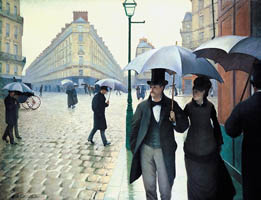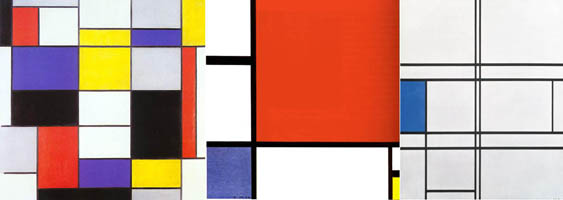“Paris Street in Rainy Weather” (1877) by Gustav Caillebotte. The artist seems to have used different shades of yellow, red, and blue to paint the cobbled ground. However, the primary color is white, giving the impression of infinite shades of white as the rain is reflected upon the streets of Paris.
Symbolism of the Color White
White objects such as clouds, snow, and flowers often appear in nature, creating many references within our human culture to the color white. In some cultures, like China’s, the color white represents death and illness. In many cultures, however, white represents freedom, purity, and innocence. This is why, for example, white is worn by brides in Western countries.
In ancient Egypt, white suggested omnipotence and purity. The name of the holy city of Memphis meant "White Walls." White sandals were worn at holy ceremonies. Ritual objects, such as small ceremonial bowls, were often white.
The high contrast between white and black is often used to represent opposite concepts, such as day and night, and good and evil. In Taoism, which has great influence in Eastern culture, yin and yang are usually depicted in black and white.
Toxic lead white was used by artists for hundreds of years before it was widely banned in the late 20th century. Lead white was commonly used not only as a canvas primer, but also for creating tints of various colors as well as highlights. Lead white was also regularly used in cosmetics, often with fatal consequences.
Wassily Kandinsky, a Russian painter and art theorist, describes his perception of the color white: “... white, although often considered as no color (a theory largely due to the Impressionists, who saw no white in nature), is a symbol of a world from which all color as a definite attribute has disappeared. This world is too far above us for its harmony to touch our souls. A great silence, like an impenetrable wall, shrouds its life from our understanding. White, therefore, has its harmony of silence, which works upon us negatively, like many pauses in music that break temporarily the melody. It is not a dead silence, but one pregnant with possibilities. White has the appeal of the nothingness that is before birth, of the world in the ice age.”
Short History of White Pigments
Lime powder and gesso where the first whites available in prehistoric times. The most important contribution to art materials from Greece was lead white, a pigment that would become ubiquitous in Western art. Modern whites are zinc white and titanium white. Thanks to its excellent qualities, titanium white has largely replaced lead white in both art and industry.
The perception of white is due to light that stimulates all three types of color sensitive cone cells in the human eye in nearly equal amounts and with high brightness.
|
Timeline of white pigments. |
|
Piet Mondrian fell in love with white. Mondrian’s most famous paintings are made up of pure red, yellow, black, white, and blue as in Composition A (1923, Galleria Nazionale d'Arte Moderna e Contemporanea, Rome), at left. Over time, though, his artwork became simpler and white became progressively more important. Wider fields of color dominated his paintings, separated by large sections of pure white, as in the Composition with Red, Blue and Yellow (1930, Wadsworth Atheneum Museum of Art, Hartford, CT), at center. Just five years later, in 1935, white itself became the focus, as in the Composition in Blue and White. Mondrian’s fascination with white was described by Charmion von Wiegand, when he visited the painter’s studio in New York: “Everything was spotless white, like a laboratory. In a light smock, with his clean-shaven face, taciturn, wearing his heavy glasses, Mondrian seemed more a scientist or priest than an artist. The only relief to all the white was large mat boards, rectangles in yellow, red and blue, hung in asymmetric arrangements on all the walls. Peering at me through his glasses, he noticed my glance and said: "I’ve arranged these to make it more cheerful." Art conservators are not entirely sure what pigments Mondrian used in his paintings. His artwork has undergone in-depth scientific analysis in the hopes of discovering the chemical compositions of the pigment used, which is essential knowledge for conservation purposes. |

 Lead white
Lead white Lime white
Lime white Titanium white
Titanium white Zinc white
Zinc white

